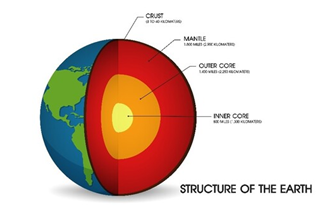

28th February 2023 (6 Topics)
Context
Researchers trying to uncover the secrets of Earth's geology have revealed the fifth layer of the planet. Seismic waves generated by earthquakes have revealed new insights about the deepest parts of Earth’s inner core.

About
- The Earth has four layers namely;
- The solid crust on the outside,
- The mantle and
- The core — split between the outer core and the inner core.
- The crust is everything we can see and study directly.
- The thinnest layer of the Earth, the crust still measures about 40 km on average, ranging from 5–70 km (~3–44 miles) in depth.
- But at the scale of the planet, that’s less than the skin of an apple.
- There are two types of crust: continental and oceanic crust.
|
Oceanic crust can be found at the bottom of the oceans or below the continental crust; it is generally harder and deeper, consisting of denser rocks like basalt, while continental crust contains granite-type rocks and sediments. The continental crust is thicker on land. |
Key highlights of the study:
- The mantle:
- The research has revealed that the mantle normally is a 2,900 km thick layer of solid rock sandwiched between the Earth’s upper crust and lower core — has been hiding two layers inside it.
- One is the “low viscosity” zone in the upper mantle, roughly 100 kilometres in thickness.
- The other layer is the ‘low-velocity zone’, which is also a part of the upper mantle.
- The low viscosity zone coincides with the transition zone between the upper and the lower mantle.
|
It was also found that mantle covers the largest area inside the earth of about 44% of the earth. |
- About Earthquakes:
- The study showed that the Earth kept moving months after the earthquake.
- The mantle’s viscous properties govern convection and help in transfer of heat between areas of different temperatures. This enables to understandplate tectonics and related phenomenon.
Significance of the study:
- The analysis showed that the partially molten layer extends from 90 km to 150 kilometres. Below this depth, the waves resume speed found in below the Turkey land.
- This layer sits below the tectonic plates, which create new crusts and destroy older ones.
- Plate tectonics is thought to have played an instrumental role in making the Earth habitable.


